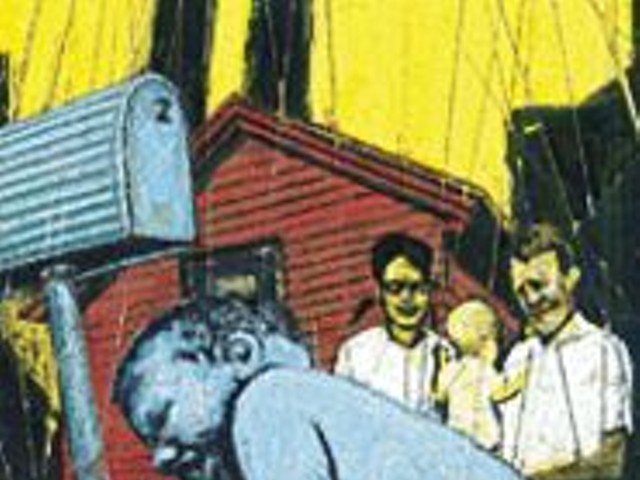On paper, at least, the community is dying. The population has dwindled to 676, down nearly 500 residents from ten years ago, according to U.S. Census figures. In the past two years, at least six public officials have been convicted of embezzling funds, worsening an already bleak financial picture in a town that's had trouble paying for fire engines and garbage trucks. Time and again, strip clubs, one of the few types of businesses still open in Brooklyn, have bailed out the village, coming up with money to meet payroll and other day-to-day expenses.
There's no better symbol of the village's despair than a tiny park next to the strip-club district. It hasn't been used for years, and with good reason. The swing set is busted, the toilets are broken and the weeds are tall. But Brooklyn will soon get a new park, thanks to U.S. District Court Judge William Stiehl, who holds the keys to a $1 million fund established seven years ago to help the village.
The fund was created from a fine paid by brothel owners convicted of money laundering. For years, Stiehl said no when village officials asked for money for firefighting equipment and other things that are supposed to be paid for by government -- the fund is designed to aid nonprofit groups that provide programs to benefit village residents. But when Mayor Dennis Miller visited Stiehl more than a year ago, the judge finally said yes.
Believing that then-Mayor Ruby Cook was a crook, Miller and other self-professed reformers took over the village Board of Trustees in 1999 [Rushton, "Welcome to Brooklyn," July 5, 2000]. Miller and his allies were proved right: Cook was convicted of stealing nearly $45,000 in village funds and sentenced to a year in prison. A few months before Cook went to jail, former treasurer Frankie Banks pleaded guilty to stealing nearly $150,000. The corruption didn't stop there. Four officials of the village park district, including its president, pleaded guilty last fall to stealing $125,000 in public money that was supposed to pay for upkeep of a baseball diamond and other recreational facilities that have fallen into disrepair and haven't been used for years.
Armed with photographs of vacant land and drawings of what might be, Miller went to Stiehl and asked for money to build a new park. It was a bold request, considering Stiehl's history of saying no to elected officials. Virtually none of the money set aside for Brooklyn had been spent since the fund was created. But here came Miller, asking for nearly half of the money.
"I just laid it out on the table," Miller recalls. "I showed him, 'Hey, it can be this. This is the way it looks now.' He bought into it."
Stiehl acknowledges he's making an exception to the rule of not using the money for government purposes. He stops short of saying he's convinced Brooklyn has made a turnaround, but he says there's hope. "I know there are good people over there, and I hope the new board and the new mayor will learn from the mistakes of the past and take this as an opportunity to better the community, which is the purpose of this whole exercise," Stiehl says.
Stiehl has occasionally bent the rules for East St. Louis, which has a similar fund set up with proceeds from fines levied against a Wall Street firm found guilty of defrauding that city. The East St. Louis fund has helped pay for a 911 system and an eye clinic, both outside the parameters of nonprofit community-based organizations that are supposed to apply for grants.
But there are few such groups in Brooklyn, despite encouragement offered by the Greater East St. Louis Fund, an organization set up by Stiehl to administer the money for Brooklyn and East St. Louis.
The Greater East St. Louis Fund paid for a consultant to draw up plans for the park and write a grant application for the Illinois Department of Natural Resources, which was initially skeptical. "Of course, there's always a little skepticism after the events that have happened here," Miller says. "One of the things that was questioned was 'OK, if we get this park, how can we maintain it?'"
Last month, the long-dormant park board met for the first time in two years and agreed to hire an auditor who will prepare monthly financial statements. Neither the state nor community-fund administrators will simply give money to village officials. The state money will be held in escrow and not turned over until the park is completed and inspected by the state, says Louis Tiemann, secretary-treasurer of the Greater East St. Louis Community Fund. Fund administrators will advance the state's portion for construction costs and be reimbursed when the project is finished. No checks will come from the community fund until administrators review billing records to confirm that costs are real. "We will fund after bills are presented," Tiemann says. "None of the money that is in our grant will pass through the treasury of the city."
Twelve acres for the yet-unnamed park is being donated by the Terminal Railroad and the local school district. Plans call for four basketball courts, a volleyball court, three play areas, three picnic pavilions, a tennis court and a baseball diamond. A nature trail may eventually be added. If all goes well, benefits will spread beyond Brooklyn, Tiemann predicts.
"It's not unusual to meet people in many of the communities around here who recall and remember the good times they've had at Brooklyn playing baseball," Tiemann says. "We feel that can be returned."





